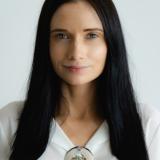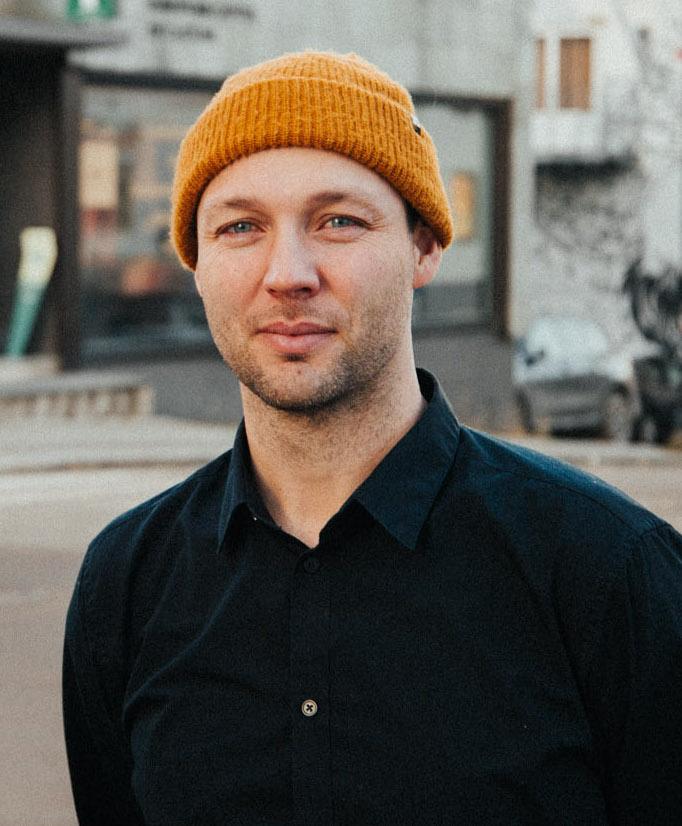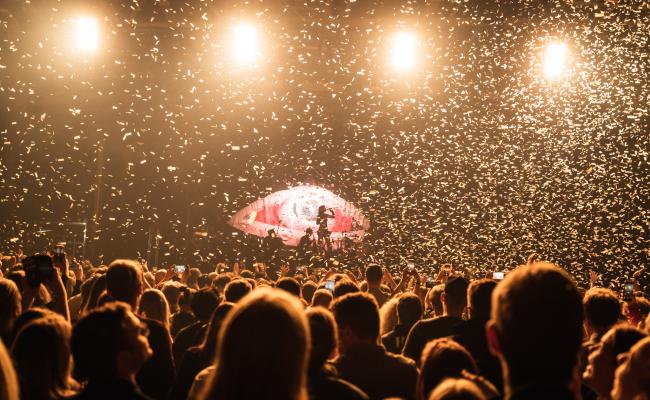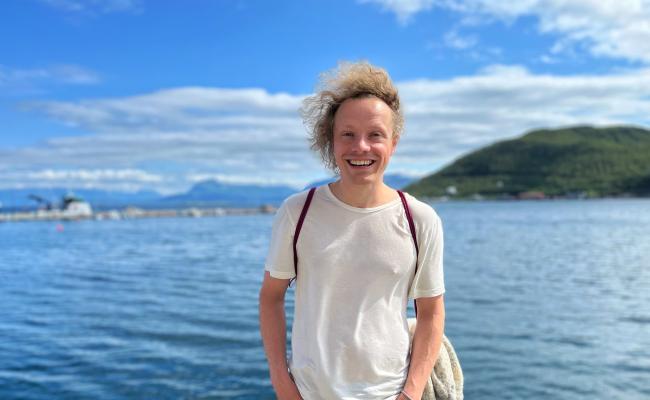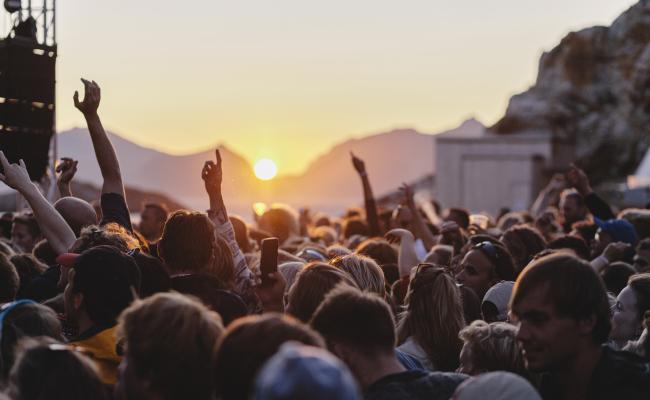European Capital of Culture: Arctic Threads Through Bodø2024

In the new year, a large and extensive cultural festival will commence in Bodø and Nordland in Northern Norway. This is the first time a city north of the Arctic Circle is the European Capital of Culture. (Photo: Ernst Furuhatt)
In February, the European Capital of Culture year opens in Bodø and Nordland with grand festivities. Throughout the year, the program for Bodø2024 offers experiences that reflect nature, culture, and society in the Arctic region and Sápmi.
February 3rd, 2024, marks the start of the European Capital of Culture year in Bodø and Nordland county in Northern Norway.
Throughout the year, the region will host a whopping thousand events with a great range – music, dance, theater, art, revues, food, literature, outdoor activities, and sports.
The Arctic and the Sámi are common threads for many of the events.
"The Arctic is a consistent dimension of the project," says Henrik S. Dagfinrud, program manager for Bodø2024, and continues:
"The EU application title ARCTICulation has followed the project since the start. We are developing artistic projects that take place in or are linked to the Arctic nature and societal development in the North. In the communication work, we emphasize that Bodø is the first Arctic capital of culture north of the Arctic Circle."
Range
In 2019, the EU evaluation panel believed that Bodø2024 had not exploited the Arctic potential sufficiently in the project. What measures have been taken since this response?
"The panel has pointed out a number of areas with developmental potential in its dialogue with Bodø2024. In some cases, these recommendations can be met with simple measures, while there are elements in direct opposition to each other that must be met with compromises in other cases. We took action by intensifying the focus on the Arctic at all stages of the project's development," says Dagfinrud and continues:
"In a similar evaluation from the expert panel in June 2022, the feedback was that there cannot only be Arctic connections in the program, but also European. We have tried to find this balance by treating our region as both Arctic and European."
In 2022, the aforementioned panel maintained, as the program manager mentions, that Bodø2024 needed "a stronger European diversity as the emphasis is on Arctic and Nordic/Baltic partnerships." In other words, the project must have a great range.
Bodø2024
- Bodø and Nordland was designated European Capital of Culture by the EU Commission in 2019 – and is the first city north of the Arctic Circle to earn the status.
- The European Capital of Culture is an EU initiative which was launched in 1985. Since then, 60 European cities have had this status.
- The initiative is meant to promote Europe's cultural wealth and diversity, celebrate cultural commonalities – and strengthen the European's feeling of belonging to a joint cultural area. In addition, an aim is to promote culture's contribution to urban development.
- The budget for Bodø2024 is NOK 310 million. Bodø municipality and Nordland County Council contribute 50 million each. The Norwegian state accounts for 100 million. Contributions from sponsors and the EU, as well as own income, amount to 110 million.
Cooperation with Umeå and Oulu
In the High North, but a little south of the Arctic Circle, there are two other European Capitals of Culture: former Umeå2014 in Northern Sweden and coming Oulu2026 in Northern Finland. These are close sparring partners for Bodø2024, according to Dagfinrud.
"We are cooperating closely with both cities. Umeå2014 has been a source of experience and inspiration from the beginning of the application process, way back to 2016-2017. The artistic leader of Umeå2014 and now the cultural director of Umeå municipality, Fredrik Lindegren, has been a board member of Bodø2024 since the creation of the organization."
"Oulu is in a completely different phase of its work. We have far more extensive cooperation with them as they are an active organization. The cooperation includes everything from the exchange of experiences and advice to specific artistic collaborations. For example, they are invited to actively participate during the opening week in February."
Attention and expertise
Earlier this fall, Bodø Mayor Odd Emil Ingebrigtsen maintained that Bodø2024 is a Northern Norwegian project as well.
What could Bodø2024 mean for Nordland and Northern Norway?
"That is a very big question. In short, it could mean increased attention, expertise, network, and experience. European Capital of Culture is a status, and if we are to get the most out of the status, each sector and industry must employ it actively. Bodø2024 is conducting a commemoration and is gathering focus throughout the year. Then, the organization is shut down, and the various societal actors must take care of the opportunities in their respective fields," answers Dagfinrud.
"Bodø2024 is strongly focused on building networks and creating sustainable projects and less focused on major individual events. For example, 12 project applications have been sent to Creative Europe [EU's cultural support program, ed. note] during the preparatory years, and five of the projects have been approved. Only one of these will be conducted by Bodø2024 itself. The conditions are very favorable for there to be a "before and after" Bodø2024," he states.
A taste of the program
In the following, a selection of Bodø2024 events with clear Northern and Arctic characteristics are presented:
Kick-off
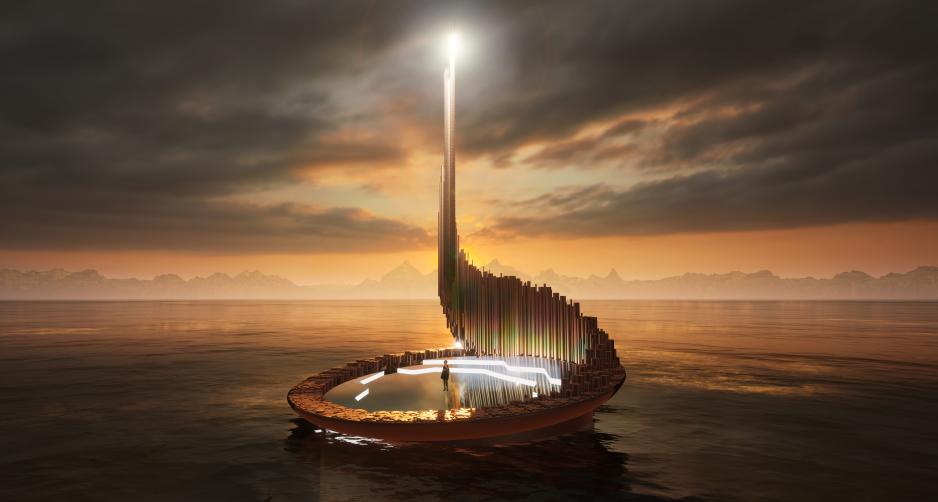
Bodø2024 imagines a grand opening of the cultural capital year in the Port of Bodø with dance, music, theater, and a light show on a floating stage. (Illustration: Phase7, Bjørnådal arkitektstudio)
The culture capital year begins on February 3rd in the Port of Bodø – regardless of weather and wind (!), according to Bodø2024. The audience is invited to gather around the port with a floating stage as the center. A spectacular and colorful opening show that mirrors Nordland's culture and heritage is promised – with the wooden Nordland boat as the symbol of handicrafts and shipping in the North, among other things.
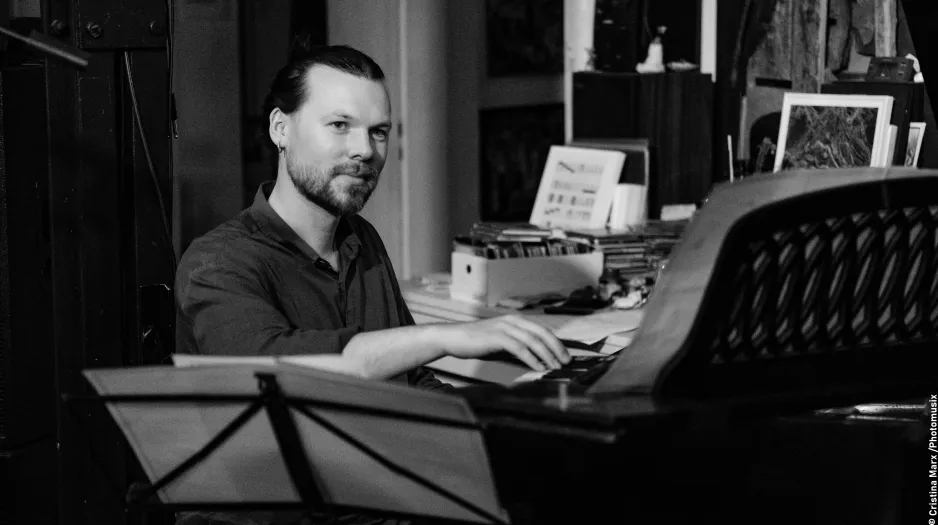
The pianist Joakim Rainer Petersen, raised in Bodø, is among the young up-and-coming jazz musicians from the North who will set the tone for the opening of Bodø2024. The light in Nordland is a central source of inspiration for Petersen's music. (Photo: Christina Marx/Photomusix)
In the evening, cold bodies can be jazzed and warmed up at the opening concert in Stormen Concert Hall.
Young, award-winning jazz musicians from Northern Norway – Liv Andrea Hauge (Mosjøen), Joakim Rainer Petersen (Bodø) og Alexander Aarøen (Balsfjord) – will present new works composed especially for Bodø2024.
They and their crews will gather on stage with the Arctic Philharmonic, the world's northernmost professional orchestra. The festival Bodø Jazz Open is also a contributor.
ÁRRAN 360°
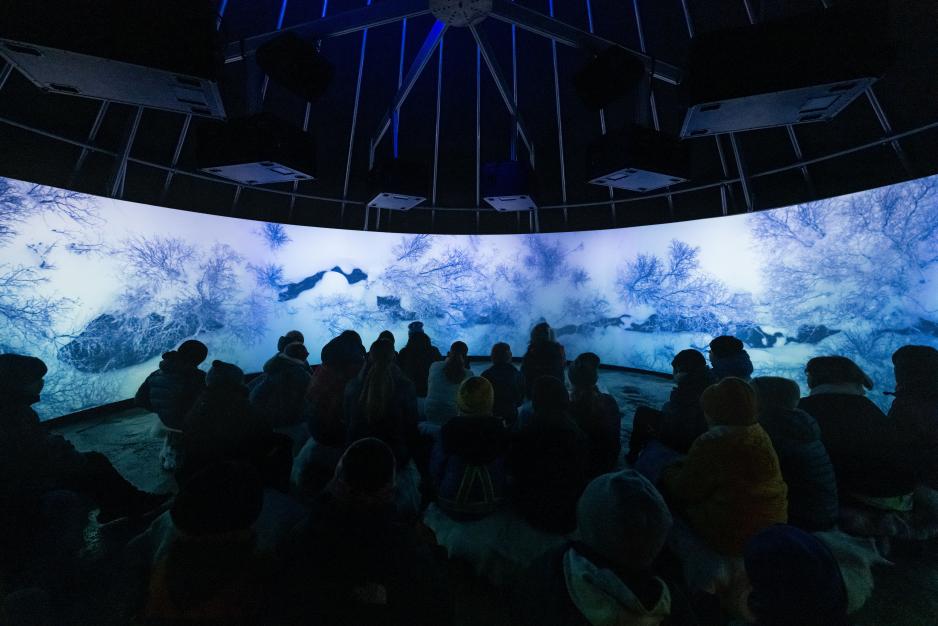
The ÁRRAN 360° project creates a distinctive space for digital Sami storytelling and film art. Árran is a Northern Sami word for the hearth in a lávvu, around which a strong Sami storytelling tradition revolves. (Photo: Knut Åserud)
From February 3rd, the audience can also enter an innovative digital realm where Sami storytelling combines high technology and new storytelling formats.
ÁRRAN 360° offers 360-degree art films by leading filmmakers and artists in Sápmi. This is the Sàmi's historical settlement area and includes northern parts of Norway, Sweden, Finland, as well as Northwest-Russia.
The films are presented in the world's largest purpose-built lávvu – equipped with a 28-meter-long screen.
This innovative Sami film project premiered in 2022 at the Venice Biennale, a prominent international art exhibition in Italy. It was also a central part of the Tromsø International Film Festival last winter. The International Sámi Film Institute initiated the project.
Now, it is traveling to Bodø with new film productions made by Ken Are Bongo, Aleksander Olai Korsnes, Ann Holmgren Aurebekk, Hans Pieski, Liselotte Wajstedt, Marja Helander, and Siljá Somby. These are both from the Norwegian, Swedish, and Finnish sides of Sápmi, and several were contributors to the first edition of ÁRRAN.
Town hall square in Bodø, 3rd-17th. February.
Juovssaheaddji – the return driver
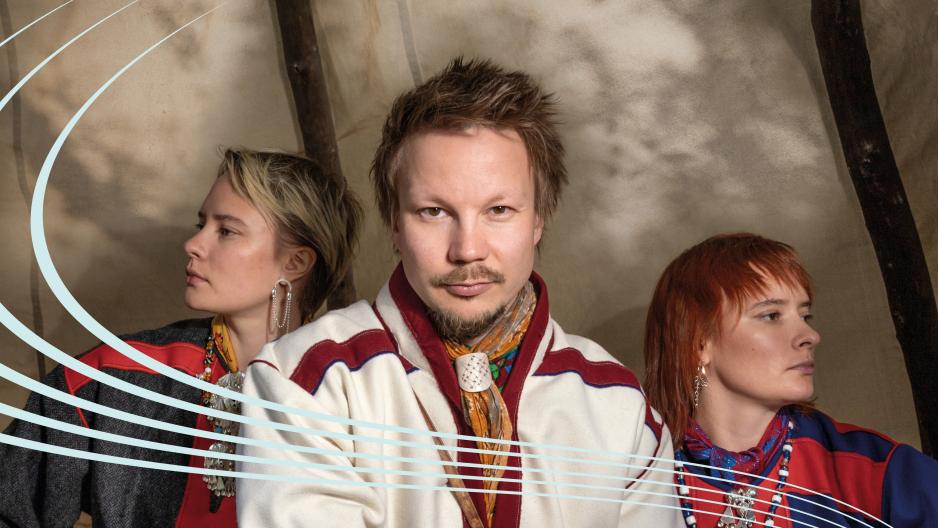
The performance Juovssaheaddji – the return driver explores the deep connection between spirituality and land rights across several artistic expressions. (Press photo)
This performance revolves around the Sámi noaid (shaman) Poala-Ánde, also known as Anders Paulsen. In February 1692, he was brought to court in Vadsø, Northern Norway, accused of using a Sámi drum and performing sorcery. This was one of the last of the major sorcery trials in Finnmark.
In court, Poala-Ánde told about the many symbols on his drum, goavddis in Northern Sámi. Some of these were connected to storm, thunder, sun, moon, and wild reindeer – while others were connected to Christian concepts of the Trinity, biblical figures, and the devil. His written narrative and preserved drum are a central source of knowledge about the old Sámi religion and its relationship with Christianity. For Poala-Ánde, life ended brutally when he was killed with an ax by an insane person before the verdict was handed down.
The performance delves into the relationship between Sámi spirituality and attachment to the land. Historical references are connected to modern land rights issues – and communicated through music, dance, junk, and poetry. As the story unfolds, it becomes clear how the 350-year-old trial against Poala-Ánde is still relevant today.
Cast: Jakop Janssønn, composer and percussionist. Niillas Holmberg, drama and poetry. Biret Haarla Pieski and Gáddjá Haarla Pieski, dance and choreography. Stig Henrik Hoff, play. Daniel Herskedal, tuba and bass trumpet. The Chamber Orchestra of the Arctic Philharmonic. Outi Pieski, scenography.
Stormen Concert Hall in Bodø, February 7th.
Giving it the right shape

The exhibition Giving it the right shape presents duodji from all over Sápmi. The pictured works are from the collection of the Sámi Art Collection in Karasjok, part of the museum foundation RiddoDuottarMuseat. (Photo: Kjell Ove Storvik)
In the cultural capital year, the new Bodø City Museum will be transformed into a Sámi museum, Bådåddjo musea.
Giving it the right shape is the opening exhibition. In this, over 50 practitioners within duodji, traditional Sami crafts, will present their works. They come from the Norwegian, Swedish, Finnish, and Russian sides of Sápmi. The works reflect different traditions and techniques, design language, and choice of materials. The curator is Kristoffer Dolmen.
Natural materials are often used in duodji, such as leather, fur, wood, roots, horn, and bone. It is common to distinguish between hard and soft duodji – where hard refers to crafts in bone or wood, while soft refers to crafts in leather and fabric. Duodji is both applied art and industry.
The Bodø City Museum, April 26th to August 11th.
From the North
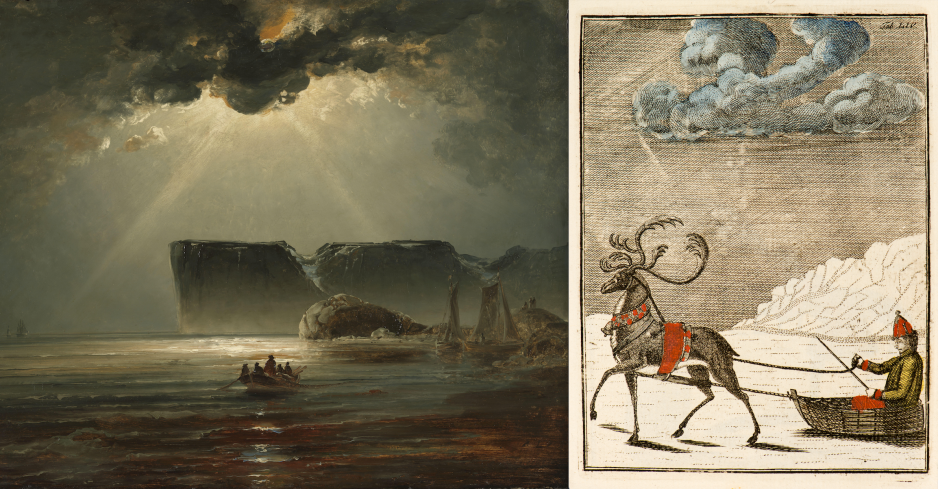
The composite exhibition From the North contains both paintings and prints. On the right: The oil painting From Nordkapp (in Northern Norway) by Peder Balke. (Photo: The National Museum/Børre Høstland). On the left: Prints part of a collection that shows the Cap of the North's pictorial history. (Press photo)
From the North [ed. translation] is a two-part exhibition with a shared title.
One part consists of paintings created by Peder Balke (1804–1887), the first Norwegian artist to depict Northern Norway. A journey in the north made a strong impression on Balke from Hedmark, and he brought these to the canvas in a characteristic way. With original motifs and distinctive techniques, Balkes' works attracted international interest. In the middle of the 1800s, the French king Louis Philippe commissioned 30 works with Northern Norwegian motifs for the Palace of Versailles. However, the February Revolution prevented the order.
The exhibition's second part offers insight into the earliest printed documentation from the High North. Terje Øiesvold presents the Cap of the North's pictorial history through a selection of prints, illustrations, and quotes from publications from 1550-1850. Central sources for such depictions were visiting Europeans. They developed interesting and surprising views of the landscape and people in the north.
Bodøgaard – art & culture in Bodø, May 4th to September 15th.
Driftwood

The dance company Kartellet and the Arctic Philharmonic find inspiration in the low tide. (Photo: Knut Åserud)
In the concert performance Rækved [Driftwood, ed. translation], a lively meeting between the playful dancers of Kartellet and Northern Norwegian folk tunes from the strings of the Arctic Philharmonic is played out.
The title alludes to everything that can be found in low tide, which can become part of something new – like how elements from different folk traditions can be woven into new expressions. The choreography combines folk dance in the north with moves from rituals and sports games. Along similar lines, the music is based on northern folk music in modern guise – mixed with musical games and rhythmic drive.
Thematically, the show tackles how we try to understand each other and interact in play and seriousness. Dansekompaniet Kartellet is a physical collaboration between men that explores male physicality and playfulness. On stage, they create intimate and powerful visual expressions.
Stormen Concert Gall in Bodø, May 25th.
The Arctic Ocean
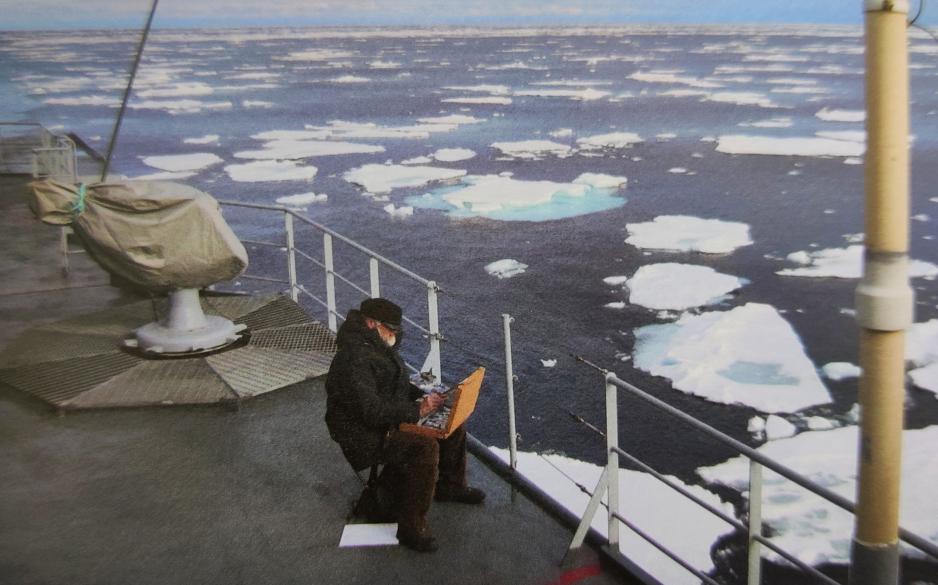
In 2004, Karl Erik Harr was a guest on the Norwegian Coast Guard ship KV Senja on a voyage in the Barents Sea. Here he is painting drift ice on the way to Bjørnøya (the Bear Island) of the Norwegian Svalbard archipelago. (Press photo)
The Arctic Ocean [ed. translation] exhibition consists of 30 paintings by Karl Erik Harr. They were painted on his travels to the Arctic islands of Spitsbergen, Bjørnøya, Hopen, and Greenland. Harr visited the first in the 1980s and the others in the 2000s.
The pictures show beautiful, strange, and vulnerable natural landscapes. With depictions of glaciers and sea ice, the paintings have been given renewed relevance in light of the rapid warming of the Arctic. Many of Harr's motifs are now gone.
Arne O. Holm, Editor-in-Chief of High North News, will open the exhibition. Geir Wing Gabrielsen, Senior Researcher at the Norwegian Polar Institute, will hold a lecture on how Arctic birdlife is affected by plastic in the sea and environmental toxins. The program also includes a lecture on polar literature by Henning Howlid Wærp, Professor at UiT, the Arctic University of Norway. Cellist Aage Kvalbein will provide a musical feature.
The Karl Erik Harr Museum on Kjerringøy, June 10th to September 1st.
Northern Expo
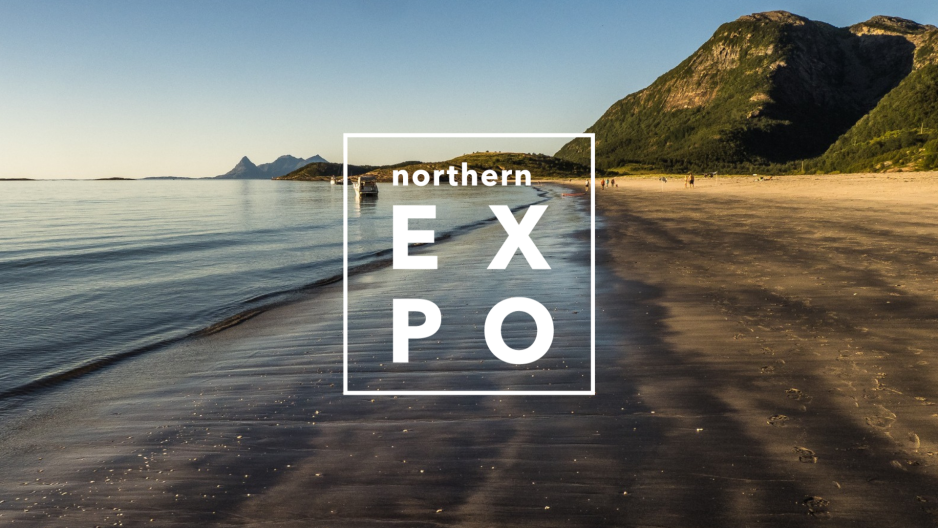
Northern Expo in Bodø will become a showcase for Northern Norwegian musicians, especially for an international, but also local audience. (Press photo)
Northern Expo is a venture to celebrate and make the music scene in the North more visible – and concurrently lifting a new generation of Northern Norwegian artists into the international spotlight.
Over the course of several days, selected artists will offer unique concert experiences within pop, electronica, jazz, rock, and folk music. The lineup will be presented in due course.
Northern Expo has previously been organized in Svalbard (2018) and digitally in cooperation with South by Southwest (2021), one of the world's largest music festivals. This showcase is intended to connect the Northern Norwegian music industry with international partners.
Northern Expo is organized by Musikkontoret Nord in collaboration with Bodø2024, Scene Nord, and Innovation Norway in Nordland.
Several places in Bodø, such as Svømmehallen scene and Beddingen House of Culture, June 13th to 15th.
See clearly, speak freely
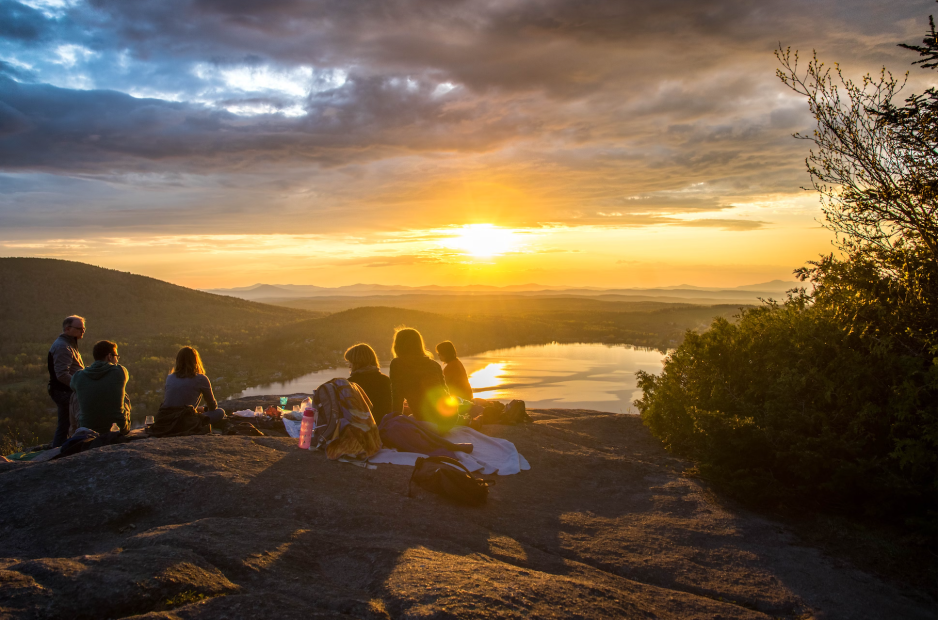
Nordic youth will gather to share and discuss their views on topics such as democracy. (Press photo)
Up to 200 young minds (13-26 years old) from Norway and the Nordic region will gather to delve into topics such as democracy, culture, and digital world challenges.
Underway, they will meet various societal leaders, share thoughts, and build skills for the future. This will be an arena where all voices are heard, misinformation is corrected, and understanding is built.
The gathering is organized by UNG2024, Bodø2024's youth project, in collaboration with Ungdom og Fritid, Unge Stormen, Ung Kultur, UNG Salten, and the youth councils in Bodø and Fauske.
In Bodø, August 6th-10th.
Project 67
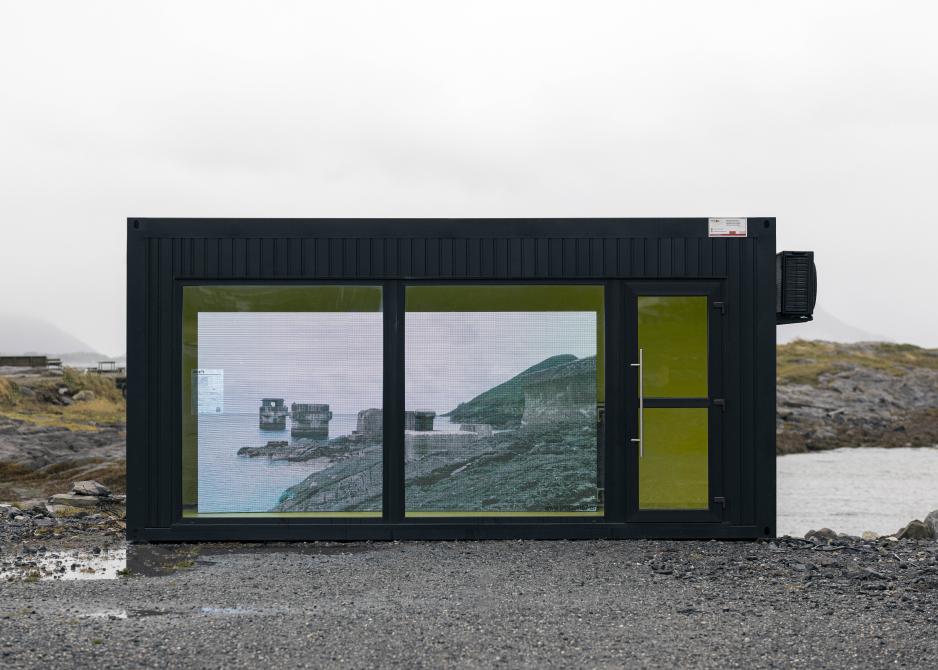
Project 67 focuses on Arctic collaboration and the accessibility of art in public spaces. (Photo: Dan Mariner/Bodø2024)
Project 67 is part of Bodø2024, which builds Arctic artistic collaboration across Greenland, Norway, Sweden, Finland, and Russia.
This late summer, the artists Julie Edel Hardenberg (Greenland), Marita Solberg (Norway), Timimie Märak (Sweden), Matti Aikio (Finland) and Alisa Gorshenina (Russia) have participated in the pre-project Threads. They have interacted with each other in Bodø and on Hamarøy and created works that will end up in a magazine.
In the new year, these artists will have residencies in the Greenlandic town of Sisimiut, at The Arctic Hideaway at Fleinvær in Nordland, or at the town of Moskosel in Arvidsjaur, Northern Sweden. There, they will work on projects to be presented in Bodø in the fall. The stays will also be filmed and turned into a mini-documentary.
In the first part of September, it will all be presented in Bodø. Each country will have a separate day focusing on its food, culture, music, etc. On day six, the project is rounded off with a screening of the mini-documentary and an electronica concert on the Svømmehallen stage with the musician Molecule, who uses sound recordings from Greenland.
Various locations in Bodø in the first part of September. Several projects will also be presented in Projekt 67's gallery outside the Beddingen House of Culture until the fall.
The New North and a literature festival
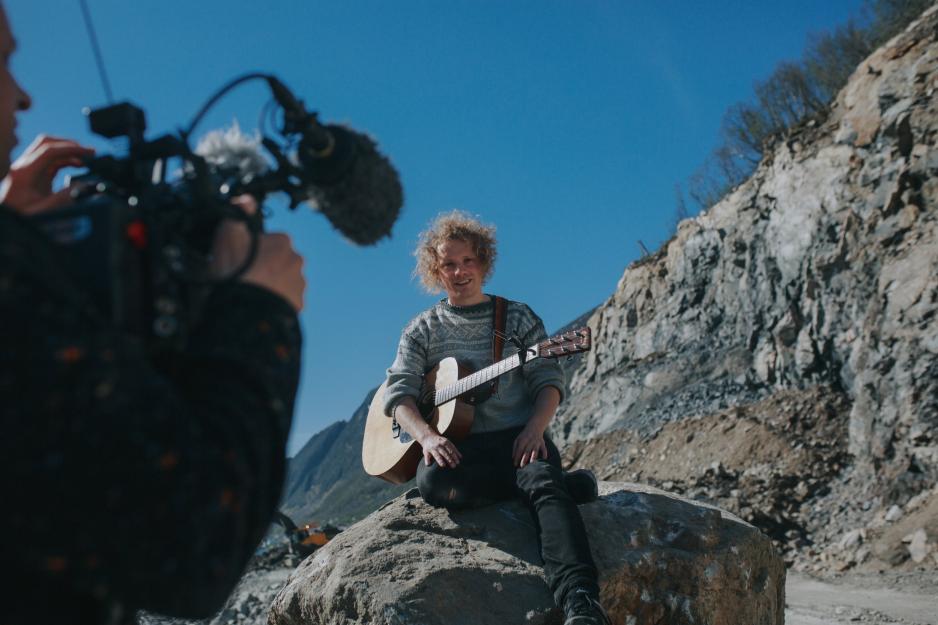
Pål Moddi Knutsen will create tones and lyrics that capture the new North, together with eight other Northern Norwegian musicians. (Photo: Byraa)
In the project The New North led by artist Pål Moddi Knutsen, old clichés will be undone, and new pictures of the region will be drawn.
Moddi and eight other Northern Norwegian songwriters have let their pens run free on field trips in various places in the region – from Kirkenes in the northeast to Træna in the south. Their mission has been to be inspired by people, nature, stories, and atmospheres and to create music that is more relevant and close to reality. Local public libraries have also served as central arenas for this fieldwork.
Participating in the project are Ida Maria and Thomas Langvann (R.Ø.D. Jazz Quartet), Jon-Are Masternes (Klish), Ingvild Austgulen (Opphav), Lars Bremnes, Emil Kárlsen, Risten Anine Gaup and Frode Larsen (Kantona).
During Bodø2024, the new northern music and poetry will be presented with several concerts. This is combined with a literary industry meeting for the library and author communities in Nordland, Troms, and Finnmark.
Stormen Library in Bodø, September 27th-29th.
Ruoktot
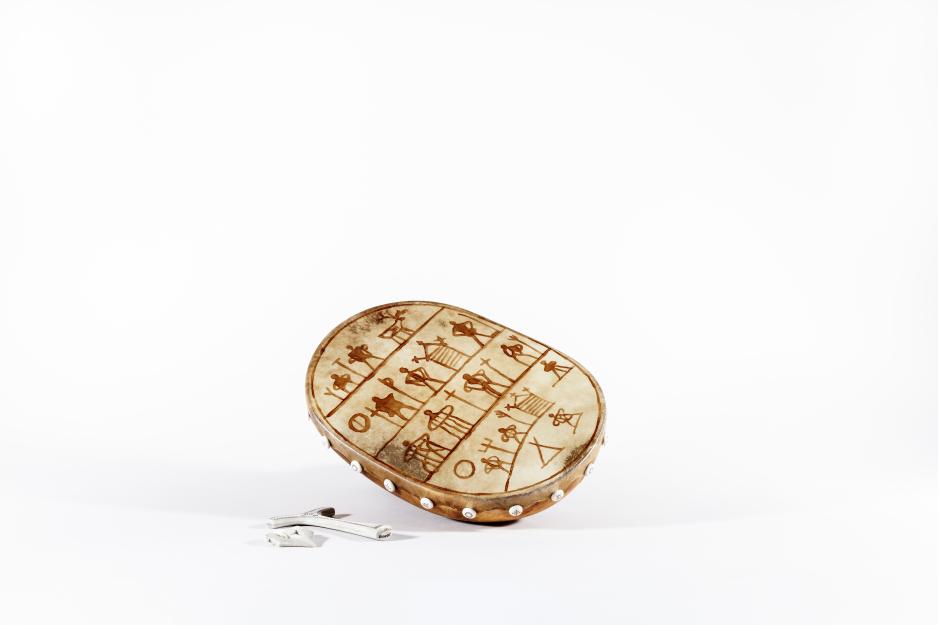
A drum made by Per Isak Juuso from Karesuando, one of Sápmi's leading artists within duodji. (Photo: Dan Mariner)
Ruoktot is Northern Sámi for returning home. With the return of Sámi drums as a theme, this exhibition shows 3D animations of five authentic drums. From the 1600s to the 1800s, many Sámi drums were confiscated by the authorities and ended up in various European museums and private collections.
Central to the exhibition is the aforementioned drum of the noaide Poala-Ánde. After several decades of effort, ownership of the drum was transferred from the National Museum of Denmark to the Sámi collections in Karasjok in 2022. The other four drums are still in German and Swedish museums.
Research-based maps and texts supplement the animations. The exhibition also includes replica drums, as well as drum-inspired artworks created by Hans Ragnar Mathisen, Iria Čiekča Schmid, Per Anders Noaidegárri, Folke Fjällström, Fredrik Prost, Håvard Larsen and Per Isak Juuso.
The exhibition is produced by the Sámi museum foundation RiddoDuottarMuseat, which, among other things, includes the Sámi collections in Karasjok.
The Bodø City Museum, November 8th to December 31st.
Nordland by light

The light festival will offer facade lighting and light installations. (Press photo)
While the Polar Night approaches in Nordland, the Capital of Culture year is concluded with the region's first light festival.
Light art will light up various locations, such as Bodø, Værøy, and Alstahaug, and invite hikes through the lights. Performances and concerts will also offer artistic depictions of light and perspective.
This is how the circle of Bodø2024 closes – which has had the light in Nordland as the starting point for its program concept ARCTICulation.
Various places in Nordland, November 11th-17th.

